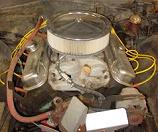Today we have the pleasure of introducing you to our new AutoblogGreen project car. The vehicle that you see in the photos is a 1966 Pontiac LeMans convertible. If you don't know what a LeMans is, or if the LeMans that you know is from the '80s, this is the car that the venerable GTO was based on. As a matter of fact, in 1964 when the GTO was introduced, it was merely an option package on the LeMans... like the ZO6 is an option package on the Corvette. Back in 1966, when GM had market share to spare, they built their cars large and rear wheel drive. This was before the age on emissions regulations, so this car is dirty. All right, all right, so it might be dirty in more ways than one! The car has been sitting in a garage, then a barn and back into a different garage for at least the last twelve years or so, and from the pictures, I am sure that you can tell. The good news is that the car is sound. The rust is all just on the surface; the floors and frame are very solid - which is the most important thing when you are considering putting an older vehicle back on the road.
Putting this vehicle back on the road is exactly what we are planning to do.
Click past the break to see what we have in store for this classic car!
Putting this vehicle back on the road is exactly what we are planning to do.
Click past the break to see what we have in store for this classic car!
Making this car a driver raises some questions, though. As was eluded to on MTV when they took an old Impala and converted it to use a modern Duramax diesel engine, these old V8-powered vehicles are horrible when it comes to emissions. We will not be replacing the engine in this car with a new one. Instead, we are going to attack this problem in a different way. First, we need to analyze exactly what the problem is. For one, the car is not fuel injected, meaning that it relies on mechanical means to dump fuel into the engine. Secondly, it runs on gas, which is most certainly a fuel of the past, not the future (hopefully!). So, these are the first two problems that we will hopefully address.
In this installment, we will be removing the carb, manifold and distributor. Each of these items will be replace at a later time. The carb will the tossed in favor of a fuel injection system. We hope to utilize individual fuel injectors for each cylinder. So far, we have obtained a new intake manifold and a Holley 900 CFM throttle body. We will be drilling and tapping holes in the intake manifold for fuel injectors, so the throttle body will pass air only into the manifold. We will be purchasing a computer to control the fuel and air mixture - very possibly a MegaSquirt by Bowling & Grippo. This system is programmable, which will allow us to tune the engine to run on gasoline or on ethanol. We have purchased an HEI distributor from a '70s GM product.
At this time, we are planning to use E85 and pump gas in this car. In order to make this work, we will be replacing the gas tank with one from a large GM sedan from the '90s, most likely an Impala or Caprice. The fuel tank will be plastic and will include a fuel pump and filter. New fuel lines will be run as well, and any rubber lines will be alcohol compatible.
If this seems like quite a bit of work, it is. As is always the case, working on an older machine which has been in the elements will complicate matters a bit. But, with classic vehicles just as popular as ever, we really should be considering what needs to be done to clean them up. It would be a shame to crush classic cars like this when there are other alternatives available.
For now, let's take a look at where we are right now. Feel free to open our gallery in a new window. Each of the thumbnail pictures embedded in the below text can be clicked on to open a larger version of the picture.


Once that was removed, we found an older Edelbrock aluminum intake manifold. This was not the factory intake manifold, and neither was the Holley carb.

Although the next picture looks almost the same, glance at the top right of the intake manifold and you will see that the accelerator cable bracket has been removed. This will no longer be needed on our project car.

Last, you will see that the distributor has been removed and the combustion chambers are blocked with rags so that no foreign objects will find their way inside the engine... 'cause that would be bad.


A few more details: the 389 cubic inch V8 engine is not stock for the car, but it is in stock condition. The engine is similar to what would have been available in the standard 4 barrel GTO. The current stock heads for the engine have small valves which restrict airflow and the 65cc combustion chambers yield roughly a 10.5:1 compression ratio. These heads are undesirable for our purposes because of the small valves. We will be replacing them with a set of no.16 heads from a 1968 GTO, which have larger intake and exhaust valves. The combustion chambers on these heads are supposed to be 72cc's, but might be slightly larger in reality. They will yield a compression ratio of around 9.66:1 and will allow the use of standard pump gas.
Keep reading in the coming weeks and months to follow along with our progress.


Sign in to post
Please sign in to leave a comment.
Continue